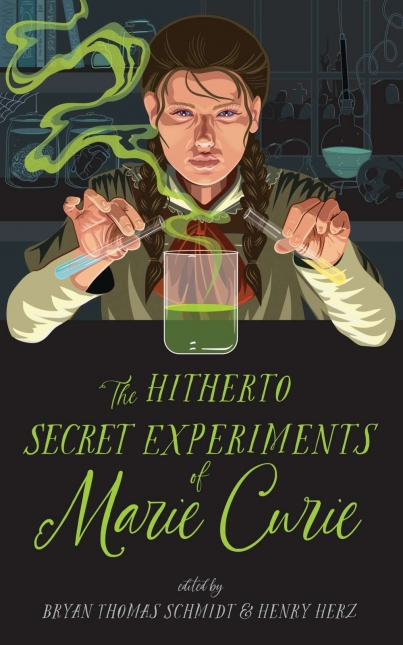The Hitherto Secret Experiments of Marie Curie
- Edited by Bryan Thomas Schmidt and Henry Herz
- Blackstone Publishing
- 350 pp.
- Reviewed by Emma Carbone
- April 20, 2023
This inventive collection conjures the Nobel winner’s younger days.

Marya Salomea Skłodowska is better known to the world as Marie Curie — a two-time Nobel Prize-winning chemist and physicist whose discoveries changed science forever. “Although much has been written about Marya, [the] younger period of her life is vaguely known,” says Bryan Thomas Schmidt, leaving the contributors to The Hitherto Secret Experiments of Marie Curie to take “liberties for the sake of entertainment” in stories and poems that blend fact and speculative fiction to reimagine Curie’s childhood and adolescence.
(While Schmidt explains that he and co-editor Henry Herz “have chosen to refer to [Curie] throughout by her Polish given name,” Marya, the collection’s very first story calls her Maria.)
The editors have gathered an impressive assortment of both bestselling authors and newer voices to tell Curie’s tale. An introduction and historical overview contextualize the offerings, many of which touch on the death of Marya’s mother and of her older sister Zosia.
The stories range from horror, like Jonathan Maberry’s “The Night Flyers,” in which double-headed eagles guarding the obelisk in Saxon Square terrorize those who might act against Russia’s occupation of Poland, to lighter-hearted fantasy, including Alethea Kontis’ “Marya’s Monster,” whose titular beast helps Marya acknowledge the grief she still carries from her mother’s passing.
It’s no surprise, given that they center on one of the greatest scientific minds of the 19th and 20th centuries, that many of the tales include a lot of actual science. (Several are followed by notes that clarify real science versus speculative flourishes, such as when radium is used for time travel.) In Seanan McGuire’s “Uncrowned Kings,” for example, a young Marya investigates the outbreak of a perplexing, sinister illness gripping Warsaw. As she tells her sister:
“When a thing makes no sense, look to the data people have left behind. If it still makes no sense, the fault is either yours, or the world’s.”
The stories are at their best when Marya is able to use her burgeoning knowledge of science and the scientific method to tackle the obstacles before her. This is especially true in “The Magic of Science,” by editor Schmidt and G.P. Charles, in which Marya has to prove that there’s a rational explanation for a classmate’s turning blue at the Polish Flying University, and in Sarah Beth Durst’s “Experiments with Fire,” which sees Marya face down a mythical, extremely dangerous Wawel dragon with help from logical experimentation.
While most of the pieces focus on or are narrated by Marya herself, Steve Pantazis’ “The Prize” notably stars one of her classmates, Adela, with the two girls vying for “the Arcanum Prize, the most coveted prize in metallurgic arts” at their Warsaw high school.
Given its recurring protagonist and common themes, the element that comes through most in this STEM-celebrating anthology is young Marya’s abiding respect for science and relentless thirst for knowledge. As she says at the close of Durst’s “Experiments with Fire”:
“Some things are unknowable. But all the rest…I will know.”
Emma Carbone is a librarian and reviewer. She has been blogging about books since 2007.

